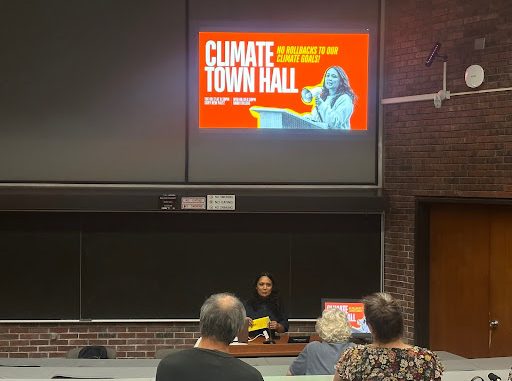
Assemblymember Sarahana Shrestha is no stranger to the SUNY New Paltz campus. She has stood on Old Main to speak about Earth Day, rallied against SUNY budget cuts outside the Student Union Building and sat on a College Democrats’ panel in the Lecture Center. On Sept. 17, the assemblywoman returned for a town hall meeting focused on climate action in New York State.
Shrestha represents District 103, which encompasses New Paltz and other towns in Ulster and Dutchess counties. Currently in the second year of her first term, she is self-proclaimed “new” at her job and a progressive champion of environmentalism. Shrestha is a rare breed politician in the year 2024 — she is a democratic socialist, climate activist.
Addressing a mixed crowd made up of about 40 college students and New Paltz residents, Shrestha focused on how New York is not on track to meet its climate goals set in 2019 with the Climate Leadership & Community Protection Act.
The act includes renewable energy targets for the state to decrease its reliance on fossil fuels and switch to renewable energy from natural sources like solar and wind. One key target is for 70% of energy to come from renewable sources by 2030. However, according to state reports, New York will miss this goal. With 2030 less than six years away, only 25% of New York’s electricity comes from zero emissions sources. Shrestha and other climate activists are alarmed. “This is terrifying,” she said.
In 2023, New York passed the Build Public Renewables Act (BPRA), which the assemblywoman championed. It authorized the New York Power Authority (NYPA), the country’s largest public power utility, to build public renewables. Shrestha offered an overview of the bill, which has NYPA do yearly assessments to check if the state is on track to reach its 70% renewable energy goal by 2030 and step in to build more renewables if not. The bill also grants cheaper energy for disadvantaged New Yorkers, requires all NYPA projects to have labor agreements with energy unions and invests in training for fossil fuel workers’ transition to the green energy sector.
More public renewables wait to be built while the bill is in its planning process. Shrestha is fighting for NYPA to build five gigawatts of publicly owned renewables by 2026 and 15 gigawatts by 2030 to reach its climate targets.
According to the assemblywoman, this number of public renewables built would also allow for the expedited phasing out of peaker plants by 2030, which are power plants that run when there is a high electricity demand. Most of these pollutant spewing plants are located in low-income communities, where people of color live.
Shrestha also addressed job concerns, a salient issue surrounding environmental legislation. “We think that if NYPA builds 15 gigawatts by 2030, that has the opportunity to create 25,000 new jobs,” she said. “We want to move the fossil fuel workers displaced by the transition to the renewable sector by making sure there’s plenty of capacity to retain them.”
NYPA is set to release a draft plan of its public renewable projects on Oct. 8. After, it will hold informational sessions to hear New Yorkers’ thoughts about its plan. The assemblywoman intends to set an agenda for NYPA ahead of their Oct. 8 plan and encouraged attendees to sign up to receive emails about the dates of the informational sessions. On Jan. 31, NYPA will finalize their plan to build public renewables.
Shrestha encouraged further mobilization by advertising a rally occurring outside the NYPA headquarters and a petition telling the governor to not rollback any state climate goals. “We don’t want to go back,” she said.
After her 30-minute presentation, the assemblywoman opened the floor for questions. She addressed her efforts to replace Central Hudson, the power company monopoly that delivers energy in the mid-Hudson, with the publicly owned Hudson Valley Power Authority. Customers have long complained about Central Hudson’s practices. The private power utility paid a $64.59 million settlement to the state Public Service Commission in June over billing issues. “We are going to look at what worked in passing [BPRA], to pass our Central Hudson bill,” she said.
“A journalist asked me, ‘People are saying this bill is dead on arrival, and how long are you going to give it?’” Shrestha said. “I was like, ‘First, who said it’s dead-on arrival? I haven’t heard that. Second, we’re going to give it as long as it takes.’”
I asked Shrestha about her frequency of visiting New Paltz’s campus, who responded how her administration values holding events in public spaces. “People who go here, people who teach here, have all invested in these places, and we want to make what our office can offer more accessible in public spaces,” Shrestha said. “We really do believe strongly in a strong public infrastructure.”
“We want people to know what the options are, so that they can decide if they want to get involved or if it sparks an idea,” she added.
As a member of Gen Z, I am not immune to our generation’s political malaise over our government’s policy failures to address defining issues — from gun control to climate change. But to hear my assemblymember discuss the same issues I had earlier in my morning Environmental Politics class, was a welcome and gratifying experience like the one Shrestha hopes to inspire.
“As a young person who grew up in the Global South, I really feel for the sort of helplessness that young people feel, because this is going to be way worse if we don’t do something about it,” she said.
“We want people to not feel helpless and cynical. We want people to know what the options are, so they can decide if they want to get involved or if it sparks ideas of what they want to do.”

